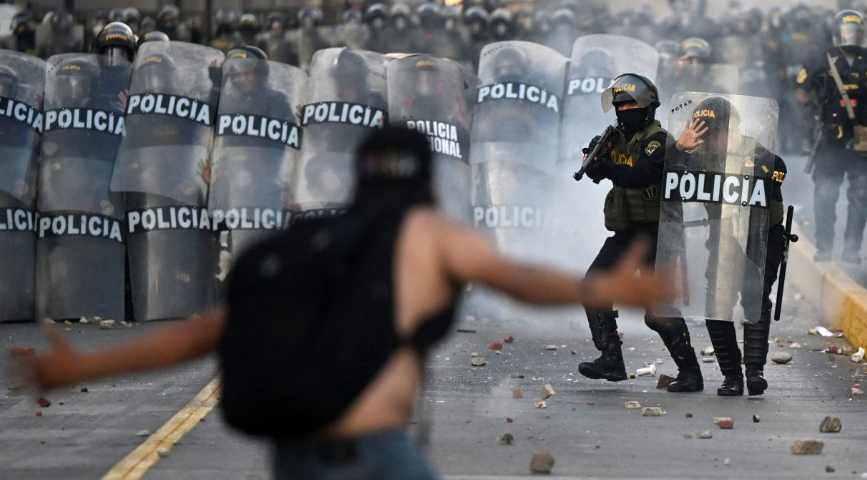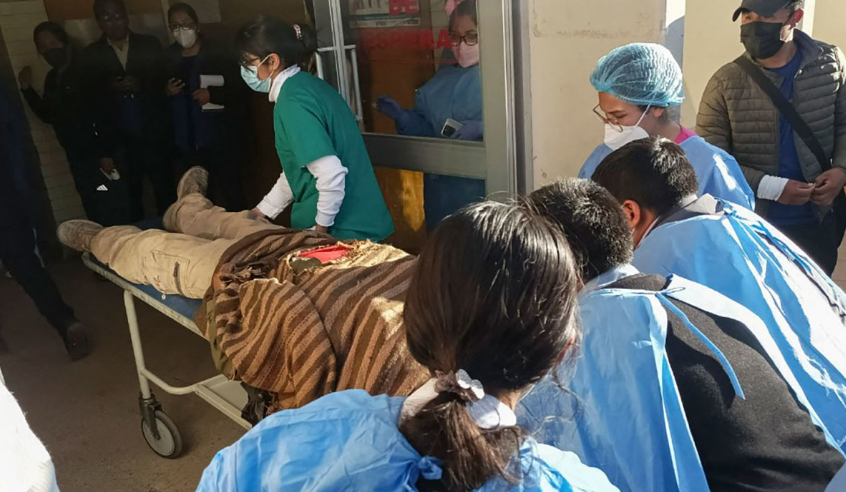‘They say we’re not Peruvian’: Protester deaths highlight Peru’s deep historical divisions

After years of relative economic prosperity and hope for the future, Peru has been shaken by months of social unrest and political instability that seem to have no end.
Thousands of protesters continue to take the streets in Lima and in the south of the country, particularly in Puno where citizens are outraged by decades of marginalization, inequality, allegations of corruption, and stagnating living standards.
Peru’s latest protest wave has seen at least 66 people killed, in a brutal series of deaths that highlight the country’s deep divisions dating back to colonial times.
Although there have been protests across the country, the vast majority of deaths were among demonstrators in southern Peru, where indigenous Aymara and Quechua people maintain their own languages and cultural traditions, as well as a sense of separation from people in urban areas of coastal Peru, particularly the capital city, Lima.
And while security forces’ crackdown on the protest movement has reopened centuries-old wounds in the country’s multicultural society, the government’s response to the ongoing protests has only exacerbated the pain among those from rural areas.
On Wednesday, Education Minister Oscar Becerra criticized Aymara women for taking their children to a protest in Lima, where police used tear gas against them.
“Not even animals would expose their children (like this). …Can they be called mothers if they expose their children to that violence?” said Becerra, who went on to suggest that the women may have “rented” the children to use for “political gain.”
Becerra later apologized. “I want to tell you that if any statement of mine has been misunderstood, I offer my sincere apologies,” he said.
In a letter published Tuesday, the country’s Ombudsman said that Becerra’s comments serve to “increase confrontation among Peruvians.”
Peru’s center and periphery
Since the days when Peru was a Spanish colony, the country’s wealth and political power have been centered in Lima. By contrast, vast swaths of the mountainous central and southern regions, as well as the vast Amazon region, remain isolated and underdeveloped.
Poor healthcare, education and transportation infrastructure have encouraged many residents from those areas to migrate to Lima in recent decades, where they often struggle to be accepted. Those who remain in Peru’s more rural areas have grown increasingly frustrated with a lack of development even during periods of strong economic growth for the country.

The southern Puno region is a microcosm of the issues facing rural Peru.
More than 70% of children there under three years old suffer from anemia, a condition associated with a poor diet, and around a quarter of the population does not have access to running water at home.
The region has been one of the most forgotten regions of Peru, with Lima politicians calculating that a small population and lack of political organization meant they didn’t have to worry about responding to their needs, according to Omar Coronel, a sociology professor at the Pontifical Catholic University of Peru.
The December ouster of President Pedro Castillo, who was accused of corruption and then impeached by lawmakers after an attempted self-coup and later arrested, extinguished hopes in Puno that things might finally change for the better under a president who had positioned himself as a champion for Peru’s most marginalized.
Access to healthcare in rural Peru has long been a sore point – the country suffered the worst death toll per capita from Covid-19 in the world – and its repercussions were felt acutely in the aftermath of protests in the Puno region.
Julia Paccsi, a 42-year-old mother of three, says she was injured by a bullet to the neck fired by security forces as she went to help injured protesters outside her house in Juliaca, the largest city in the Puno region, on January 7.
Paccsi didn’t immediately go to hospital out of fear of being taken for a protester and arrested, but when she did finally go a few days later she was told there were no doctors in the city who could treat her.
“In the hospital they didn’t treat me because they told me that there aren’t neck and head specialists,” she said through tears. “We don’t have head and neck specialists here.”
Paccsi had no option but to travel to Lima for surgery and is still waiting for a second procedure.
The father of another victim, a 17-year-old girl who was shot and killed near protests at Juliaca’s airport on January 9, believes that his daughter could have survived if there were better medical services in the region.
“There aren’t any ambulances, there aren’t good doctors that can help people that are injured,” said Demetrio Aroquipa.
“That day we went out together with my daughter, my other daughter and my wife to the market,” he said. “Four of us left, but only three and a coffin came back. She was a psychology student, a responsible girl. My daughter lost her life when a bullet hit her. I want justice.”
In February, human rights group Amnesty International released a report ascribing the violence of the Peruvian state’s response to “systemic racism ingrained in Peruvian society and its authorities for decades,” according to the organization’s regional director Erika Guevara-Rosas.
“Dozens of people told Amnesty International they felt that the authorities treated them like animals and not human beings,” Guevara-Rosas added.
Peru’s government has denied “systemic racism” and reiterated its support for the ongoing investigations for the deaths and injured during the protests, according to a statement released by the Ministry of Justice and Human Rights.
Rubbing salt into old wounds
One of the protesters’ demands is the resignation of President Dina Boluarte, who has been in office just three months.
She angered many in Puno in January when she blamed unsuccessful talks with representatives from the region for the failure of attempts to stop the protests.
“We have to protect the life and tranquility of 33 million Peruvians. Puno is not Peru,” she added.
Boluarte was forced to apologize a day later, and a statement from her office said her words had been misinterpreted.
But for many it was too late.
“They say we aren’t from Peru, but Puno is Peru,” Aroquipa told reporters in Lima – a common response among protesters from the region.
You May Like
- Wenn Schwarze Schwarze hassen
- Biden zeigt keinerlei Müdigkeit: «Wir fangen gerade erst an»
- «Washington Post»: Chinas Ballone sind Teil eines Überwachungsprogramms, mit dem Peking weltweit mil
- Amerikanische Navy fischt abgeschossenen Ballon aus dem Wasser – China spricht von «Informationskrie
- Haunted by post-election riot, Brazil’s Lula reins in army
- Marjorie Taylor Greene ist das neue Gesicht der Republikaner
- Two dead after foiled $32.5 million airport heist in Chile
- US-Polizist verschickte nach brutalem Einsatz Fotos des verletzten Opfers Tyre Nichols
- Four Americans kidnapped in Mexico were found in days. More than 100,000 people in the country remai
- Der American Way of Life macht die Menschen immer dicker
